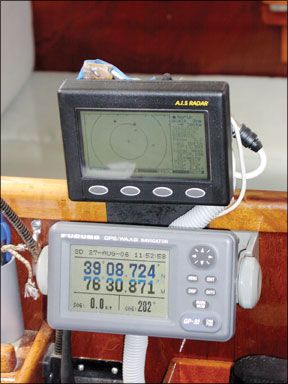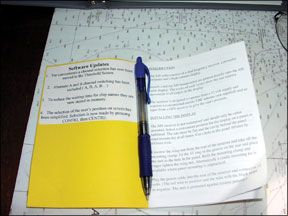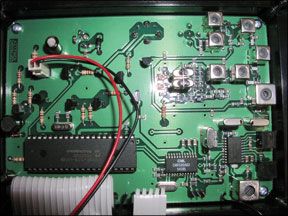Starting in 2002, the SOLAS regulations (chapter V, regulation 19) required that all ships over 300 gross tons carry and operate at all times an Automated Identification System. The shipboard AIS sends brief broadcasts on a VHF radio frequency with the ships information, including the vessels name, latitude and longitude, course over ground, speed over ground, heading, status, and Maritime Mobile Service Identity (MMSI) number. The broadcasts happen every few seconds. Last summer, we got a chance to try an AIS receiver on a 2,500-mile trip from Baltimore, Md., to Bermuda, Nova Scotia, Maine, and back to Baltimore. For the trip, we installed the Nasa Marine AIS Radar. In this case, Nasa Marine is not NASA (the U.S. space agency), but is instead a British company known for low-cost marine instruments. *** Back in 2002, we sailed our boat from Bermuda to Providenciales, Turks and Caicos. We carried a radar detector to alert us to nearby ships. However, most of the time, it didnt. We surveyed all the ships we could see during daylight hours and found 288 that 80 percent were not spinning their radar antennas. No wonder the radar detector didnt alert us! The notable thing about the radar detector is that it is a passive device (listens only), and therefore, doesn’t take much power. We could leave it on 24/7 without worrying about battery drain. We just couldnt trust the tool since the ships were running with their radars off. We could have run our radar, but running it just at night killed our batteries. We decided we needed a better passive system. One solution is the Automatic Identification System (AIS) from SOLAS (Safety of Life at Sea). Starting in 2002, the SOLAS regulations (chapter V, regulation 19) required that all ships over 300 gross tons carry and operate at all times an AIS. Briefly, the shipboard AIS broadcasts ship information on a VHF radio frequency, including the vessels name, latitude and longitude, course over ground, speed over ground, heading, status, and Maritime Mobile Service Identity (MMSI) number. The broadcasts happen every few seconds. Last summer, we got a chance to try an AIS receiver on a 2,500-mile trip from Baltimore, Md., to Bermuda, Nova Scotia, Maine, and back to Baltimore. For the trip, we installed the Nasa Marine AIS Radar. In this case, Nasa Marine is not NASA (the U.S. space agency), but is instead a British company known for low-cost marine instruments. 288 The AIS Radar is not radar. The name comes from the way the instrument displays the received AIS data from ships. The AIS Radar plots the ship data it receives on a radar-looking screen with your boat at the center of the screen. It also is not a replacement for radar. The AIS Radars plotted targets will not offer as complete a picture as a conventional radar. AIS doesn’t see fishing boats, buoys, or rocks; radars and sharp lookouts do. And remember, if you have a radar, the International COLREGS require you to use it for collision avoidance. However, our experience has shown that many radar-equipped commercial vessels do not use their radars. But in our informal survey during this voyage, every ship we saw had an AIS identifier. 288 The AIS Radar is 4.5x6x2.5 inches, and weighs 1.4 pounds. It is designed to mount in a bulkhead in a 4×5.5-inch hole. It is not waterproof. Installation is easy, except a separate VHF antenna is required (no antenna sharing). Rig an antenna (e.g., on the pushpit), give it 12-volt power, connect your GPS NMEA output, and connect the alarm. The AIS has a graphics LCD screen that uses a backlight at night. The screen is adequate for use at a nav station. There are four soft key buttons along the bottom edge that change their functionality based on the screen contents. The good news is that the Nasa AIS Radar works. When running, it takes 0.090 amps, which means that over 24 hours, it will take only a little over 2 Ah. The backlight does not significantly change the power usage. There are two range rings on the screen that can be adjusted out to 32 nautical miles (nm). If the alarm is on, any vessel within the inner ring that has AIS installed and running will set off the alarm. Each ship showing up on the screen is depicted with an informative symbol, defining the ships status (moored, steaming, not under command, etc.). The right-hand side of the display has the ships information. Pressing a soft key moves the focus to the second closest ship. Once the last ship has been reached, it starts over again with the closest ship. Nasas latest software for the AIS Radar allows it to track up to 30 vessels, and ships names are “remembered,” so as users move from ship to ship, they don’t have to wait for a ship to rebroadcast its data before the AIS Radar displays it. (Anyone with an older unit can get the software upgrade from Nasa Marine for about $20.) We generally ran with a 16-nm range, which meant the alarm went off at 8 nm. Most of the time, the AIS Radar “saw” the ships before we did. Conclusion Even though the Nasa Marine AIS Radar worked, it did have a number of problems. The menu functionality is awkward to use and not intuitive. A ship that is selected is hard to see on the LCD screen (too tiny). Not all ships broadcast all information, so the AIS Radar might display a heading of 511 (29-1, a computer default value!). Backlight intensity is not adjustable. On is too bright at night (why a white light?), and off means that there is no way to know in the dark what button to press because the button functionality changes based on the last thing you were doing. The display works only in a north-up orientation, which is great if youre going due north. Another improvement testers would like to see is a way to acknowledge a ship within the alarm area so that the alarm could be reset to pick up any other ships entering the zone. As it stands, users have to wait until all ships leave the zone before turning the alarm back on. Testers also noted the Nasa AIS Radars skimpy manual. In our opinion, the information about the electrical characteristics of the alarm output signal needs beefing up. Testers found Nasas alarm too quiet, so they installed a different alarm, with a power converter circuit so as not to overload the unknown alarm signal (see photo, p. 22). Attempts to contact Nasa Marine about this have gone unanswered. SI-TEX Marine private labels the device and offers a two-year parts/one-year labor warranty. SI-TEX-branded units are available at 


AIS technology is a great safety aid. It wont replace radar, but it will cut down on at-sea collisions.







































